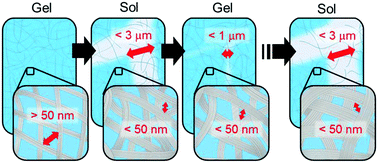Evolution of heterogeneity accompanying sol–gel transitions in a supramolecular hydrogel
Abstract
When a peptide amphiphile is dispersed in water, it self-assembles into a fibrous network, leading to a supramolecular hydrogel. When the gel is physically disrupted by shaking, it transforms into a sol state. After aging at room temperature for a while, it spontaneously returns to the gel state, called sol–gel transition. However, repeating the sol–gel transition often causes a change in the rheological properties of the gel. To gain a better understanding of the sol–gel transition and its reversibility, we herein examined the thermal motion of probe particles at different locations in a supramolecular hydrogel. The sol obtained by shaking the gel was heterogeneous in terms of the rheological properties and the extent decreased with increasing aging time. This time course of heterogeneity, or homogeneity, which corresponded to the sol-to-gel transition, was observed for the 1st cycle. However, this was not the case for the 2nd and 3rd cycles; the heterogeneity was preserved even after aging. Fourier-transform infrared spectroscopy, small-angle X-ray scattering, and atomic force and confocal laser scanning microscopies revealed that, although the molecular aggregation states of amphiphiles both in the gel and sol remained unchanged with the cycles, the fibril density diversified to high and low density regions even after aging. The tracking of particles with different sizes indicated that the partial mesh size in the high density region and the characteristic length scale of the density fluctuation were smaller than 50 nm and 6 μm, respectively.



 Please wait while we load your content...
Please wait while we load your content...